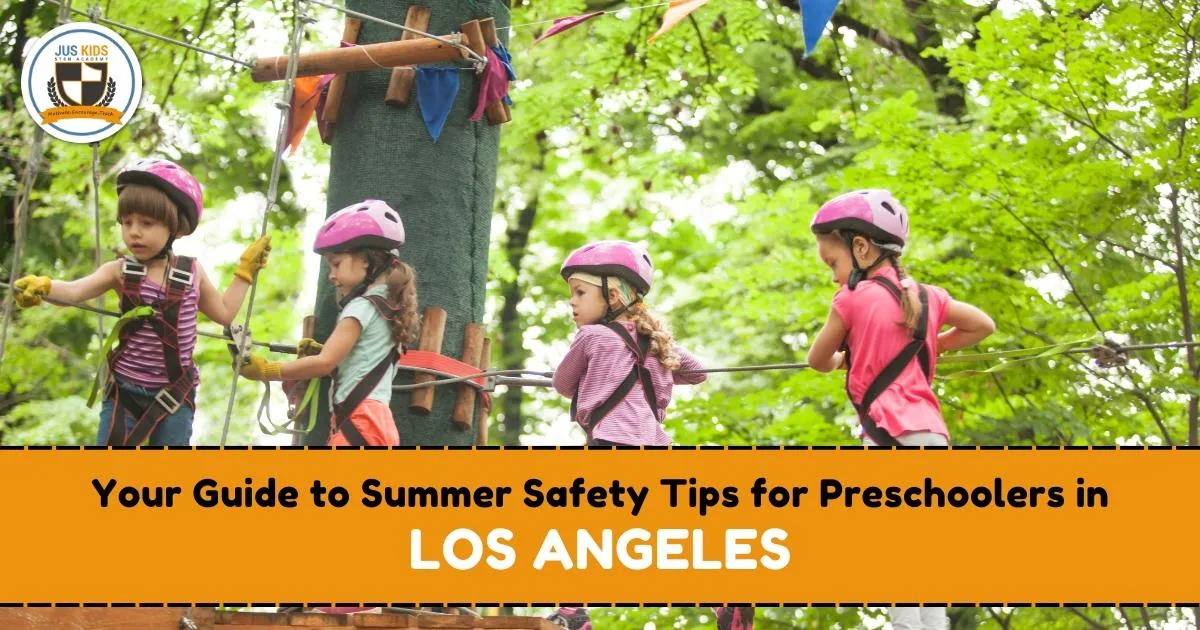
Summer Safety Tips for the Preschoolers in Los Angeles
Summer in Los Angeles means sunshine, outdoor fun, and endless playtime. But for parents of preschoolers, it also brings a whole new set of worries. How do you keep your energetic little one safe under the blazing sun, especially when they seem to have zero fear?
Imagine you’re at the park, and your preschooler takes off toward the playground barefoot, giggling and unaware that the metal slide could burn their skin. That’s when you realize summer safety is not optional. Preschoolers are curious, fast, and fearless. That’s why knowing the right summer safety tips for preschoolers is essential for a fun, accident-free season.
This guide covers everything from heat protection and water safety to how you can make safety routines fun and engaging for your preschooler.
Why Summer Safety Is Different for Preschoolers
Preschoolers are at a stage where they’re exploring, learning through touch, and testing limits. That means they’re also more vulnerable to heat exhaustion, sunburns, and playground injuries.
Because they don’t always understand risks, parents have to be one step ahead. What’s obvious to an adult may be invisible to a child. Their skin is thinner, their sweat glands are still developing, and they won’t tell you they’re overheating until it’s too late.
Key preschool safety tips:
Avoid outdoor play during peak heat (10 AM to 4 PM).
Always check surfaces before your child sits or climbs.
Use shade creatively—umbrellas, hats, or stroller covers
2. Protecting Little Skin from the Sun
Sunburn is one of the most common summer issues for kids, and it happens faster than you might think. One bad burn during childhood can double the risk of skin problems later.
Apply sunscreen 15 minutes before sun exposure and reapply every two hours. Choose a broad-spectrum SPF 30+ designed for kids. If your preschooler resists the sticky feeling, turn it into a game: “Let’s paint on your invisible armor!”
Summer safety tips for preschoolers:
Wear wide-brimmed hats and UV-protective clothing.
Encourage play in shaded areas
Reapply sunscreen after water activities, even if it's water-resistant.
3. Staying Hydrated and Energized
Kids can get dehydrated quickly, especially when they’re too distracted by fun to stop and drink water.
Offer small sips often and make it playful. Try water bottles with characters they love or frozen fruit ice pops made at home. Avoid sugary drinks—they don’t hydrate as well and can upset their stomach in the heat.
Summer safety for kids tip: Carry a refillable bottle everywhere, and make a game out of who can drink their water “like a superhero.”
4. Water Play Without Worry
Splash pads, kiddie pools, and beach days are fun, but water accidents happen fast. Preschoolers should always be supervised around any water—even a bucket can be dangerous.
Enroll them in water safety classes early if possible. And remember, floaties and inflatable toys are not substitutes for supervision.
Preschool safety tips around water:
Never leave a child unattended near water.
Set boundaries before entering a pool or beach
Teach them basic water rules like “no running” or “wait your turn.”
5. Safe Clothing Choices for Summer
Lightweight, breathable fabrics like cotton help regulate body temperature. Avoid dark colors that absorb more heat.
Slip-resistant shoes are a must, especially on wet or sandy surfaces. Flip-flops can be cute, but they’re not always stable for little feet running at full speed.
Preschool safety tips include:
Opt for shoes with grips or sandals that fasten securely.
Choose bright clothing for easy visibility in crowds.
Have a backup outfit in your bag—spills and mud happen.
6. Bug Bites and Outdoor Allergies
Insects love summer too. Mosquito bites and bee stings can lead to itching, swelling, or allergic reactions. Use kid-safe insect repellent and avoid scented lotions or soaps that attract bugs.
If your preschooler is sensitive to pollen, check daily forecasts and plan activities when pollen is lower.
Summer safety tips for kids:
Apply insect repellent on clothing instead of skin when possible.
Keep antihistamines handy if allergies are known.
Teach kids not to touch unknown plants or bugs.
7. Safe Outdoor Exploration
Los Angeles offers so many parks, trails, and open spaces. While it's great to explore nature, kids can wander easily.
Practice name: Recall games and teach your preschooler your phone number as a song. Always dress them in bright colors, and consider temporary ID bracelets when visiting busy areas.
Preschool safety tips when out and about:
Use strollers with sunshades for long walks
Set visual boundaries (e.g., “stay where I can see you”).
Carry a recent photo in case you get separated.
8. Heat Illness Warning Signs
Preschoolers may not express discomfort until it’s serious. Be aware of signs like flushed skin, excessive sweating, dizziness, or irritability.
If you see these signs, get them into shade, offer water, and cool them with damp cloths. When in doubt, seek medical advice.
Summer safety for kids means:
Take frequent breaks during outdoor play
Keep play sessions short during high temperatures.
Always trust your instincts if your child seems off.
10. Keep a Summer Safety Kit Handy
A small, portable safety kit can make all the difference during outings. Include items like
Band-aids
Kid-safe insect repellent
Sunscreen
Instant cold packs
Rehydration drink mix
Hand wipes or sanitizer
Spare clothes
It doesn’t have to be fancy. Just be consistent about taking it wherever you go. Having this kit is one of those often-forgotten summer safety tips for kids that pays off.
Create a Summer Safety Routine
Children love routines—they create a sense of security. Build safety habits into your summer schedule. For example, “sunscreen before shoes” or “water bottle before play.” Turn them into chants or songs. Make safety fun, not scary.
Smart summer safety tips for preschoolers:
Use visual charts with stickers to track habits.
Role-play “what to do” scenarios at home
Reinforce rules with praise and encouragement
Teach Through Play
Preschoolers learn best through hands-on activities. Act out safety rules with puppets, draw summer safety scenes, or sing songs about sun and water. Interactive learning helps kids retain information without feeling lectured.
Summer safety for kids activity ideas:
“What’s wrong in this picture?” games
Matching games with safety gear
Reward systems for remembering safety steps
Recognizing Signs of Trouble
Knowing when it’s more than fussiness can help you act fast.
Watch for sunstroke signs: high fever, vomiting, confusion, or rapid breathing.
If bitten by a bee or an allergic reaction occurs, look for swelling, wheezing, or a rash.
See a doctor promptly if minor injuries like scrapes become red or infected.
These may feel like big worries, but knowing what to watch lets you keep summer fun and safe.
Your Role as Parent and Safety Coach
Kids don’t always hear what we say, but they notice what we do. Model sun-safe behaviors and hydration habits yourself. Talk about safety calmly and consistently.
Be patient, it takes time for preschoolers to build awareness.
Preschool safety tips for grown-ups:
Stay consistent with the rules
Be present and engaged during outdoor time
Celebrate progress, not perfection.
Final Thoughts
Summer can be full of magic—popsicles, sprinklers, laughter—but safety gives you the freedom to enjoy it all without fear. When you practice smart summer safety tips for preschoolers, you help them build habits that last a lifetime.
Remember: safety doesn’t mean saying “no” all the time. It means saying” yes” confidently, joyfully, and with just the right amount of preparation.
Looking for a preschool that gets summer safety? Just Kids Academy in Los Angeles creates a safe, playful environment that puts your child’s well-being first.
FAQs
1. How can I help my preschooler stay cool during outdoor play?
Dress them in breathable cotton, plan outdoor time early or late in the day, and offer water breaks often.
2. Is it safe for preschoolers to wear sandals in summer?
Closed-toe shoes are better for active play to prevent stubbed toes, slips, and falls on hot surfaces.
3. What should I do if my preschooler refuses sunscreen?
Make it fun by letting them apply a small amount themselves or use sunscreen sticks or sprays with fun scents.
4. How often should I reapply sunscreen on my toddler?
Every 2 hours, or sooner if they’re swimming or sweating—even if the label says water-resistant.
